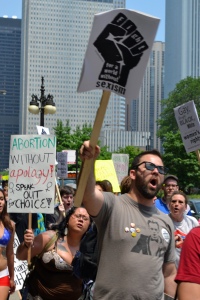On August 18, 2010, Tiawanda Moore went to the Office of Internal Affairs to file a complaint, alleging that a police officer had sexually assaulted her. Getting the runaround from the officers at Internal Affairs, and feeling threatened and intimidated, she pulled out her Blackberry to get proof that they were refusing to help her file her claim. As many of you know by now, Ms. Moore was charged with “eavesdropping” on the police, a charge that can bring up to 15 years in jail.
Today, I’m so happy to announce, she was acquitted, and her nightmare is over.
But there are lessons to be learned from this, and changes that are needed, and I think it’s important that we take the time to think about what happened here, and what it says about the need for systemic reform.
I was in court today, along with my good friend and colleague Mariame Kaba and a small group of supporters. The closing arguments we heard spoke volumes about the injustice that this young woman – and I fear, young women in general – experience at the hands of the police and the states’ attorney.
“THEY WERE STALLING, INTIMIDATING HER, BULLYING HER NOT TO MAKE A COMPLAINT.”
Ms. Moore’s attorney, Robert Johnson, spoke eloquently about her experiences of injustice. His description of what had happened to Ms. Moore, based on the testimony and the tape itself, which had been played for the jury, filled in some of the details on her harrowing experience at Internal Affairs that you may not have heard.
First, he said, when she made the appointment, she was told to bring any witnesses who could support her allegations. She brought her boyfriend, but he was immediately told to go home or go to McDonald’s to wait for her; no interview was held. The police urged her not to file a complaint, insisting that the assaulting officer was “a good guy.” On the tape, there’s a promise that what happened to her will never happen again (proving, as Robert Johnson pointed out, that they believed that she had been assaulted). There’s the insistence that instead of filing a complaint, she should “go a different route.” (On cross examination, the officer admitted, correctly, that there is no other route for victims of police sexual harassment in the system.) And there’s the fact that when she became concerned and wanted to speak with another officer, the police locked the door and told her she could not leave.
Imagine how scary this experience must have been. Imagine the power dynamics in the room, of this 19-year old young woman trying to plead her case to two police officers, and getting this kind of response.
The only conclusion you can reach is the one Robert Johnson reached:
“The plan was to kill this complaint from the very beginning…. They were stalling, intimidating her, bullying her not to make a complaint.”
HERE WE GO AGAIN, FRAMING THE VICTIM AS THE PERPETRATOR
And what did the State have to say about what happened? Brace yourself, because here’s their theory.
Tiawanda Moore, they said, was on a “fishing expedition.” They alleged that this young woman came in all the way from Indiana, not because she had been assaulted by a police officer and wanted to make a complaint. No, the real reason according to the State was that she “wanted them to say the case was going nowhere. That’s what she wanted them to say.”
What? Didn’t she say on the tape itself that she’s concerned about how many other young women have been sexually assaulted by this officer? Absolutely, said the State, and that is just proof that she was “editorializing,” by which I suppose they meant she was trying to make her case for public consumption.
If this sounds crazy to you, like the world’s gone mad, consider the State’s conclusion as to the power dynamics at play when she went to file her claim. Is it the police that are in a position of power? No.
“It is her that is in control…. You can’t push Tiawanda Moore around, she’s not going to let you.”
After all, the State’s Attorney added, “What motive do the police have to protect this officer?”
“JUST ANOTHER DAY IN INTERNAL AFFAIRS”
Now that we can breathe a huge sigh of relief that Tiawanda Moore won’t be facing jail time for this travesty, I am left with a deep fear that what she experienced may in fact be, to quote the State’s Attorney, “just another day in Internal Affairs.”
The concerns raised by groups like the ACLU, and activists like Chris Drew, over the Eavesdropping Law are important and valid. Our avenue for defense against all types of abuse of power by law enforcement must be protected. Citizens should be able to record police abuse, and to use recordings to hold the police accountable for such abuse in court. Period.
Beyond that, though, let’s not lose focus on how the system failed this young woman at every level. It is important that we remember that Tiawanda Moore’s terrible experience with the system as a young woman survivor of violence was most likely not a fluke. Instead, her experience points to what young women are up against, and the need for systemic changes.
Young women in Chicago are at risk of sexual assault by the police. Tiawanda Moore is certainly not the only young woman to allege that she has been sexually assaulted by a police officer. In Chicago, and in other cities as well, young women have come forward to say that they have been assaulted by their local police officers. Here in Chicago, there have been rallies in support of survivors of police violence, and groups such as Women’s All Points Bulletin – whose director, Crista Noel, was present in court as well to support Tiawanda Moore today – are working to draw attention to these cases, and to provide crucial support for women.
And can we really believe, as the state alleges, that Internal Affairs is deeply committed to supporting survivors of police violence? Literature from Chicago Activists Against Police Sexual Assault, a new group that is holding rallies around the issue, quotes these statistics from a 2007 study by the Mandel Legal Aid Clinic at the University of Chicago.
- The odds that a Chicago police officer charged with abuse will receive any form of meaningful discipline are 2 out of 1,000. But as the U.S. Dept. of Justice has found, only 1 in 10 citizens ever even report police abuse for fear of reprisal, and distrust of the investigatory process.
- Between 2002 and 2004, 85% of abuse complaints were dismissed without ever interviewing the officer.
- 75% of Chicago police officers with multiple charges of abuse never receive any discipline whatsoever
- Brutality complaints are 94% less likely to be found as having sufficient evidence by the Chicago Police Department (CPD) than in the nation as a whole.
Yes, it does sound like what happened to Ms. Moore was what might be expected on any typical day.
And now we can add the State’s Attorney into the mix. For months, the Taskforce has called for the State’s Attorney to drop these ridiculous charges against Tiawanda Moore. They refused. Today’s closing arguments made it clear that the State’s Attorney cannot be relied upon to protect young women from police violence. The topsy turvy world view that was presented in court today – a world in which young women supposedly have power over the police – was startling and frankly, frightening.
We all have a lot of work to do if we are going to make Chicago safer for young women. Systems change at every level is called for. What are your thoughts about what needs to be done?







